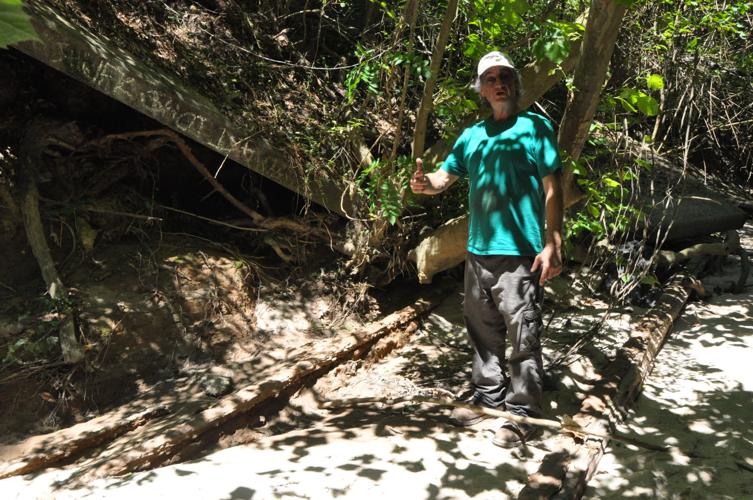During the 1830s, the South Carolina Canal & Rail Road Company built the Charleston & Hamburg Railroad, which ended in an area of South Carolina that later became Aiken County.
Because the 136-mile line was the longest in the world, the completion of its construction represented an unprecedented engineering feat.
Remnants of the railroad were found, examined and documented during a recently completed Cultural Resources Survey in Hitchcock Woods.
Some were the remains of an inclined plane, or funicular, which was built where a slope was too steep for the early locomotives to travel up and down safely.
Railings made of wood and rusting iron that were part of what used to be two parallel tracks lie partially uncovered in sandy soil, and there also are wood pilings that are still standing.
“I don’t know anyplace else at all quite like this, so it’s unique, basically,” said Bobby Southerlin of Archaeological Consultants of the Carolinas. “It was the most complicated part of the whole railroad basically. It’s the evolution of technology.”
The Hitchcock Woods Foundation contracted with Southerlin, who is based in North Carolina, and Carl Steen of the Diachronic Research Foundation in Columbia to conduct the survey in the winters of 2015, 2016 and 2017.
Hitchcock Woods covers approximately 2,100 acres and is one of the nation’s largest urban forests. The other discoveries made there during the survey’s three phases included Native American artifacts that were thousands of years old, a whiskey still and an intact pottery kiln that probably was built around the time of the Civil War.
While giving a brief tour to several people May 16, Southerlin took them to a site where a brickyard once operated after the group viewed the railroad rails and pilings. Then he took a quick side trip with one other person to the former location of a fire tower.
Where the fire tower once overlooked the longleaf pines, there now are only four concrete footings, which have iron bars in them. They formed the tower’s base.
Southerlin believes the tower was built in the early 1900s and might have had a wood frame and a metal roof.
“This is the highest point in Hitchcock Woods,” Southerlin said. “It (the fire tower) was sort of the beginning of the plan to take care of Hitchcock Woods."
The Aiken Fire & Ornamental Brick Company began producing bricks and pipes, which were made of clay, in 1891 and was out of business by 1900, Southerlin said.
He pointed out places underneath the trees where there are a cistern and the crumbling foundations of structures that could have been kilns.
“There is a lot of brick debris all around here,” Southerlin said.
While conducting the Cultural Resources Survey, Southerlin, Steen and their team of workers studied maps and LiDAR images of Hitchcock Woods. They also made shovel test pits and carried out excavations to gather information and unearth historical objects for the Hitchcock Woods Foundation.
“Now that our Cultural Resources Survey is complete, our goal is to develop a management plan that will help us protect and preserve these areas and our rich Woods heritage,” said Courtney Conger, chairwoman of the Hitchcock Woods Foundation’s Historic Preservation Committee.
Southerlin is excited because the opportunities for more exploration and research abound in the approximately 2,100 acres of forestland.
“The survey was just the start,” he said. “Hitchcock Woods is like a big educational laboratory, and in the future, it would be ideal if the foundation would allow archaeologists to target the specific things they are interested in. I would like to continue studying the railroad independently. It is a personal interest of mine.”










